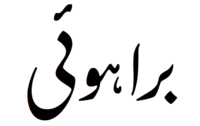
Back Brahui Afrikaans اللغة البراهوية Arabic البراهويه ARZ Idioma brahui AST Brahui dili Azerbaijani براهویی دیلی AZB Брагуі (мова) BE-X-OLD ব্রাহুই ভাষা Bengali/Bangla Brahweg Breton Brahui Catalan
| Brahui | |
|---|---|
| براہوئی | |
 The word Brahui written in the Nastaliq script | |
| Pronunciation | [bɾaːhuiː] |
| Native to | Pakistan, Afghanistan[1] |
| Region | Balochistan |
| Ethnicity | Brahui and Baloch |
Native speakers | (2.8 million cited 1980–2017 Census)[1] |
| Perso-Arabic Script (Nastaʿlīq), Latin script | |
| Official status | |
| Regulated by | Department of Brahui, University of Balochistan |
| Language codes | |
| ISO 639-3 | brh |
| Glottolog | brah1256 |
 Brahui (far upper left) is geographically isolated from all other Dravidian languages.[2] | |
 Brahui is classified as Vulnerable by the UNESCO Atlas of the World's Languages in Danger | |
Brahui[3] (/brəˈhuːi/ brə-HOO-ee;[4] Brahui: براہوئی; also romanised as Brahvi or Brohi) is a Dravidian language, spoken by the Brahui and Baloch people, primarily in central areas (Brahuistan) of the Pakistani province of Balochistan; with smaller communities of speakers scattered in parts of Iranian Baluchestan, Afghanistan, and Turkmenistan (around Merv).[5] It is also spoken by expatriate Brahui communities in Iraq, Qatar, and the United Arab Emirates.[6] It is isolated from the nearest Dravidian-speaking neighbouring population of South India by a distance of more than 1,500 kilometres (930 mi).[2] The Kalat, Khuzdar, Mastung, Quetta, Bolan, Nasirabad, Nushki, and Kharan districts of Balochistan Province are predominantly Brahui-speaking.
Brahui is the only Dravidian language that is primarily written in the Perso-Arabic script. It is also written in the Latin script.
- ^ a b Brahui at Ethnologue (26th ed., 2023)

- ^ a b Parkin 1989, p. 37.
- ^ Cite error: The named reference
University of Balochistanwas invoked but never defined (see the help page). - ^ "Brahui". Oxford English Dictionary (Online ed.). Oxford University Press. (Subscription or participating institution membership required.)
- ^ "A slice of south India in Balochistan". 2017-02-18.
- ^ "International Journal of Dravidian Linguistics, Volumes 36-37" department of linguistics, University of Kerala[full citation needed]